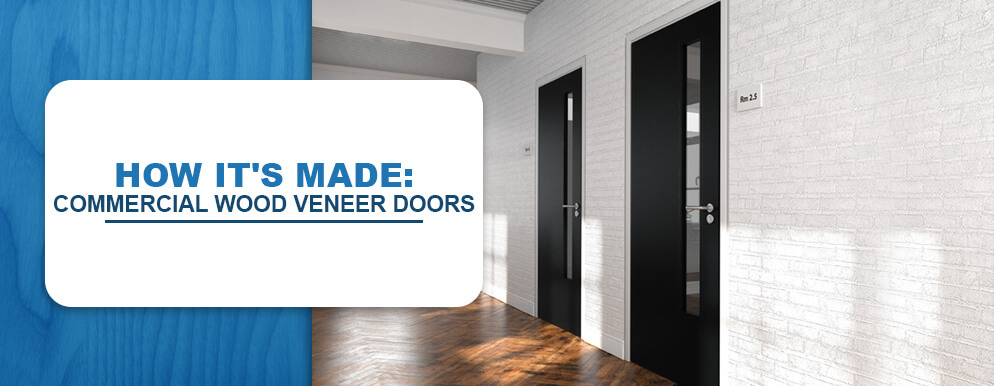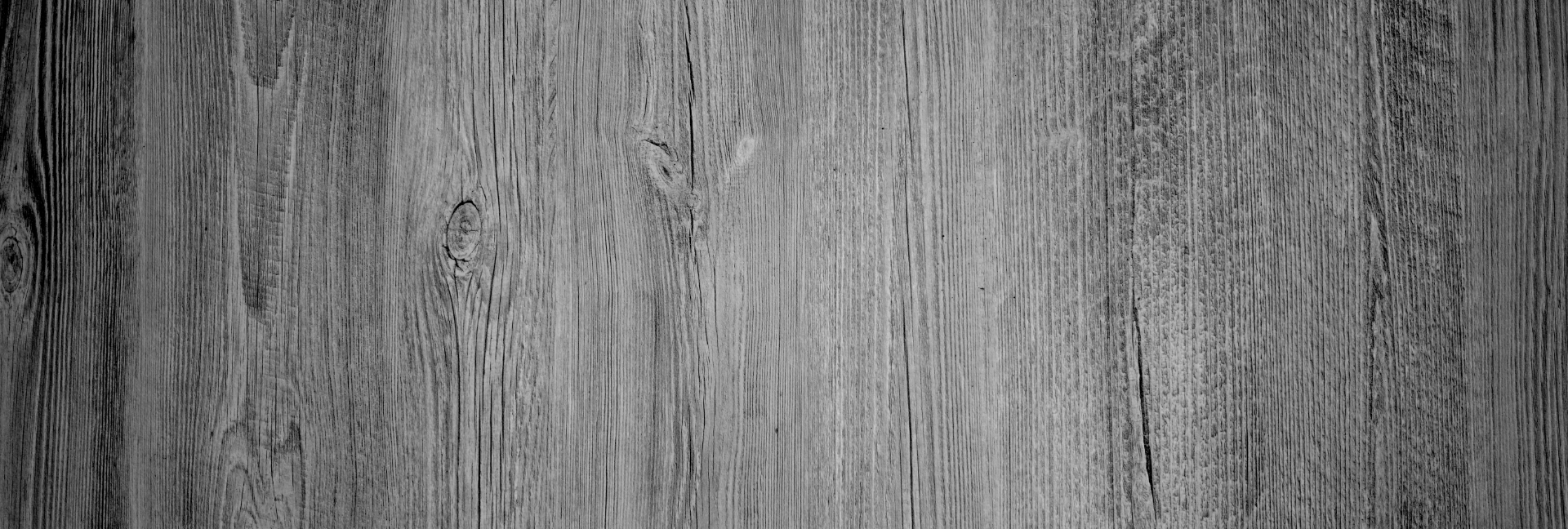


Whether hollow, solid or “diet,” wood veneer doors add an attractive touch to any business. They offer a professional appearance and long-lasting performance at affordable prices.
But have you ever wondered how the wood veneer doors you work with every day are actually made? To make them, we follow a process that creates consistent, quality results. It involves making the veneer from the logs, manufacturing the core, sizing and cutting the door and inspecting and finishing it. Keep reading to find out more about this process.
The first step in creating a wood veneer door is to make the veneer itself. The term veneer refers to thin slices of wood that can provide a solid-wood appearance to a large surface area. They significantly lower the costs of a door and also help to make it flush. Many types of wood make for an excellent veneer. Common choices include red oak, black walnut, white ash, black cherry and sugar maple.
First, workers carefully select harvested logs for veneer quality. Some of the features they look for include the cylindrical form of the log, the location of its geometric center and the consistency of its growth rings. Once selected, the workers scan the logs for any metal, such as fence wire or nails, as these can easily damage the cutting equipment. Cut logs then soak in a steaming bay for a few days — the time varies from species to species — to remove any accumulated ice from the winter and soften up the fiber. Digital technology can help workers determine when the logs are at the right softness for cutting. Having the right temperature is vital to ensure the correct color and smooth cuts.
Next, the logs are debarked. An operator carefully aligns the log and trims only the smallest amount of bark necessary to avoid waste. The log goes on a spindle and rotates quickly. As it rotates, a tool peels off the bark, leaving a perfectly cylindrical log.
Once formed into cylinders, the team at Manhattan Door cuts the veneer in one of four ways.
To see examples of these cuts, take a look at our page on veneers.
All of these processes slice off thin layers of wood about 1/8 of an inch thick.
In the next step, the supplier cuts these long strips into smaller, more manageable pieces that they stack and organize according to their grain patterns. At this point, the workers remove any defects in the wood.
After they stack the pieces according to their grains, the supplier glues the sheets together. They adhere these sheets to each other in one of several ways:
Now that they’ve joined the sheets, they stack them. The door face is made up of three veneer sheets, with one sheet sandwiched in between two others and glued together.
The veneer manufacturer then places the sheets into a hot press of over 100℃. It does not take long for the glue to cure and for the three sheets to become one panel of plywood, usually less than a few minutes. It is then ready for sanding.
At Manhattan Door, we can also send a veneer out to be “prefinished clear,” which involves adding a clear coating, finishing the veneer right when the door is made, rather than adding a finish after assembly.

What are interior doors made of? The core of the door can be made with a few different materials. These include solid, hollow and “diet” cores, which all offer varying benefits, depending on your project.
This step is where Manhattan Door puts together the door components into a single unit. We source our materials from the highest quality of suppliers. The veneer is combined with the core, stiles and rails. Stiles and rails are parts of the door’s borders, with stiles making up the vertical bars and rails being horizontal.
All components are cut to size before going through the glue spreader. Once the glue is on, we piece the door together and put it through a press. The press may be hot or cold, depending on the type of door.
Up next is the trimming and machining of the door, followed by assembly. Each door goes through one or more of these steps depending on the customer’s specifications.
All doors go through our trimmer, which takes off a portion of each edge of the door so that it is square and meets the desired door measurements. We can provide doors as slabs, where they are not machined further after being trimmed.
For doors that are getting machined, we will cut in features such as holes for cylindrical locks, space for hinges, vision light cutouts and decorative grooves. We often use computer-aided design (CAD) software to program hardware that is machined into the door. Our most common requests are for hinges and a lock, but any combination of those features and others are available.
During assembly, we can install any glass, vision kits, louver or molding in the door as well. Bifold doors are also put together here.

After everything is put together, we inspect the door for quality. The inspection includes looking for any knots or rot sections embedded in the wood veneer. Other materials used in construction have to meet certain quality standards as well. For instance, glue and stains cannot exceed the emissions limits for volatile organic compounds, which are harmful chemicals that can damage the atmosphere. They are also checked for their adhesion quality and penetration to make sure that they are working correctly.
Assuming everything checks out at quality control, we move on to finishing the door. For any Medium Density Fiber (MDF) veneered doors, we will use a water-based white primer to prime the doors. For customers who select to have their doors custom finished, our finishing vendor handles this next step in the process.
At the start of the finishing process, the door is sanded, finished and sealed. Sanding the door removes any roughness and provides a smooth texture. Many sanders are machine-guided through CAD programs and can finish a door in no time. Since wood veneer is so thin, an error here could easily wear through it, which is why machine guidance is helpful. People using the door will touch the side frequently, so it’s crucial to remove any splinters and sharp edges on the sides. Sanding a door makes it able to receive a stain or paint more readily and makes it more comfortable to the touch.
After sanding, a door may be stained. Stains can intensify the color or bring out entirely new tones and are an important part of achieving the proper color. Putting down an even coat is essential, as ensuring the stain reaches into all the nooks and crannies. Alternatively, many MDF doors are simply sprayed with a primer.
The next step is to add a finish or topcoat, which can add another layer of protection to a door, including water resistance and general protection from scuffs and scrapes. This finish can also add a high gloss or matte effect to the door.
To see some of our machinery at work, check out this video, which walks you through our facility.

You can expect a finished door from Manhattan Door to resist warping and keep swinging for years to come. It can include protective finishing and extensive customization options such as extra hardware cutouts. The completed door comes with first-class construction, fine-grit sanding and a protective finish. It may also offer benefits such as fire resistance, insulation and soundproofing.
Once we finish making our doors, we send them right to you. We take precautions to keep your doors looking as good as they were when they left our facility. We crate the doors and protect them before we send them off so they’re ready for distribution or installation when they arrive. Fast shipping is part of our commitment to quick turnaround times. Finished doors should be stored in dry, well-ventilated areas and only installed once a building is enclosed, wet work is complete and an HVAC system is operating.
One of the most frustrating times for a contractor is when their materials are delayed or slow-moving. This can disrupt their schedule and make for an unhappy client. At Manhattan Door, we have a typical turnaround time of two to three weeks. We also offer a “Door-N-24” service that enables us to get your order to your even faster.

As you can tell, our wood veneer doors are versatile, cost-effective and attractive. They make for a great addition to any business and come in a wide variety of options that fit any design. However you want to use your wood veneer doors, the Manhattan Door can make it happen fast. If you want spaces for locks or key cards, we can do that. If you would like a door that is solid but lightweight, we have that option.
Our quality results and fast turnarounds are supported by our advanced 100,000 square-foot facility in Carlstadt, New Jersey. This top-tier facility, combined with over 80 years of experience, makes Manhattan Door the place to go for custom door solutions. Explore our product pages to learn more about the types of veneers and doors that we offer or contact us with any questions you may have.
